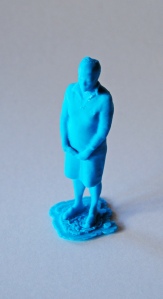Being passed bodily among a group of strangers, I’m starting to feel a little self-conscious and quite glad I wore leggings under that skirt.
“Do you mind,” one of my fellow the workshop participants asked politely, handing me back to myself, “if I take a photo of you … with you.”
Having signed on for a 3-D printing workshop I’d became the very embodiment of the future – boldly going where no Weekly journo has ever been before.
For the best part of an hour all eyes had been upon me, first as I was subjected to a 3-D body scan and then, by miracle of additive manufacturing, rendered into a small plastic smurf.
Now the audience held Mini-Me, quite literally, in the palm of their hands.
Having joined The Robots Are Coming workshop instructor Scott Phillips’s stable of creations, including several “organic monsters”, naturally the first thing I’m worried about, being a writer, is copyright.
Do I own the right to the 3-D map of me?
“I imagine there will be laws around this like photography,” Phillips says.
But there are so many much bigger questions.
We have all come to this workshop with a desire to understand the technology which will shortly turn the world on its head.
Among the participants is a program manager from Billy Blue College of Design wondering at its application for her students, and a former 3-D games designer who knew the day would come when the virtual world would become reality.
One couple has come to try to solve a dilemma. “My husband really wants a 3-D printer, but he doesn’t know what he wants to do with it,” the woman alongside reveals.
Right now, for masses at least, 3-D printing is where the home PC was in in the ’80s.
But with key patents to expire next year 3-D printers will eventually become like giant flat screen TVs and Dutch pancake makers for the technologically and gizmo-susceptible.
Already you can buy a machine like Phillips’s demonstration model UP Plus 3D printer for under $2000.
But unless you are really wanting to make chess sets of your friends and family, plastic jewellery or other items that look like they might come from a cereal box it’s hard to see much use for them at a household level right now.
Even the very savvy Phillips has only a substitute part for a dishwasher, a bottle opener, a key holder and a couple of egg cups to show by way of useful objects.
But it is the application of the different types of 3-D technologies on a grand scale that is really mind-blowing – from food fabrication to printing functional human tissue and ultimately body parts using living cell “bio-ink” to printing a two-storey house in less than 24 hours.
Phillips agrees with the 3-D game designer we are “still a long way off from printing a girlfriend”, but adds it won’t be long before he can print a chop for dinner.
Then there is the mind-bending prospect of 4-D printing capable of changing shape when exposed to water, heat or mechanical pressure.
Racing ahead, there is the day scientists master printing in graphene – a super material so strong and light that “a sheet no thicker than clingfilm could hold an elephant wearing stilettos”. Of course, Phillips jokes, you’d have to print the shoes first!
It all leaves me feeling rather one dimensional.
